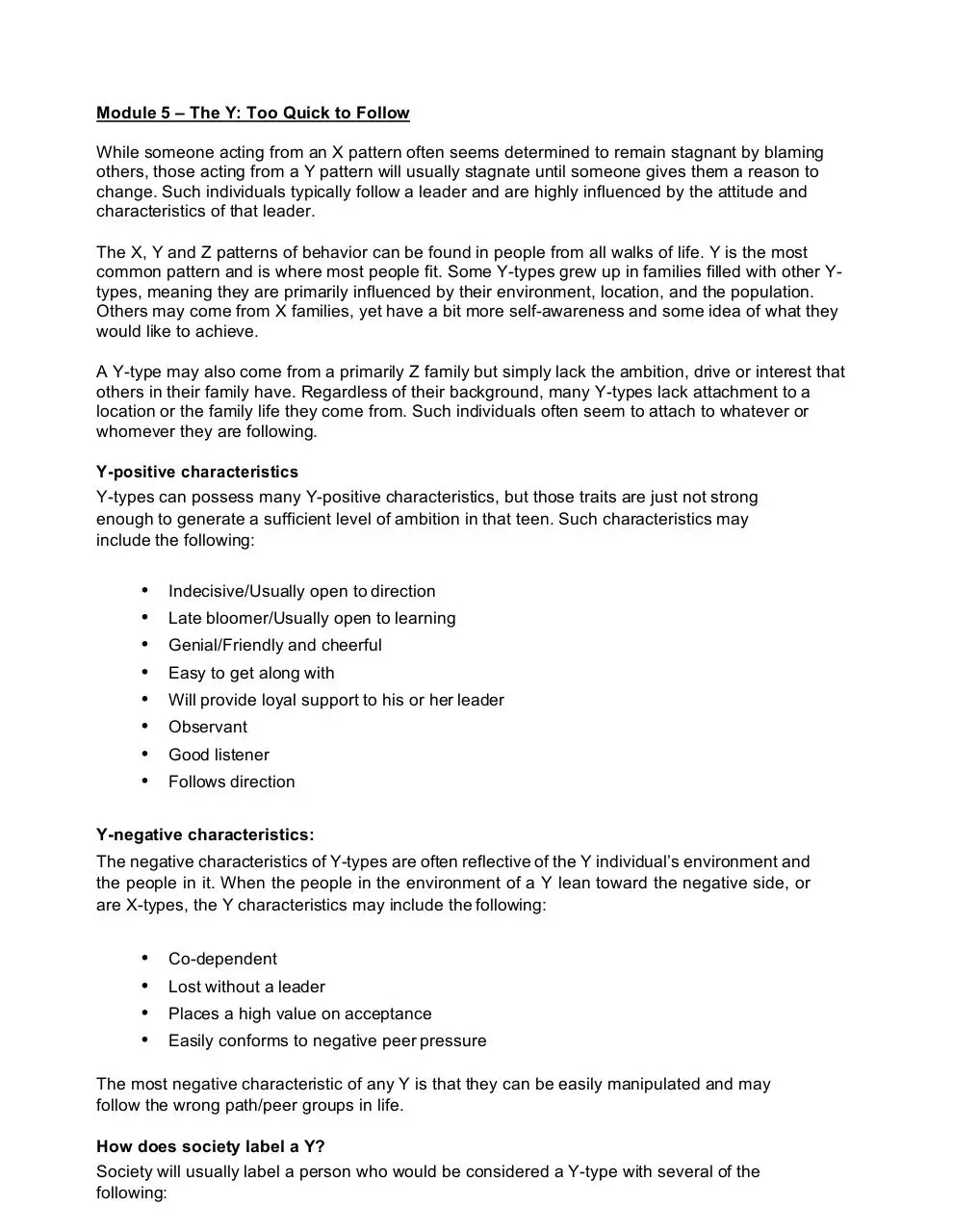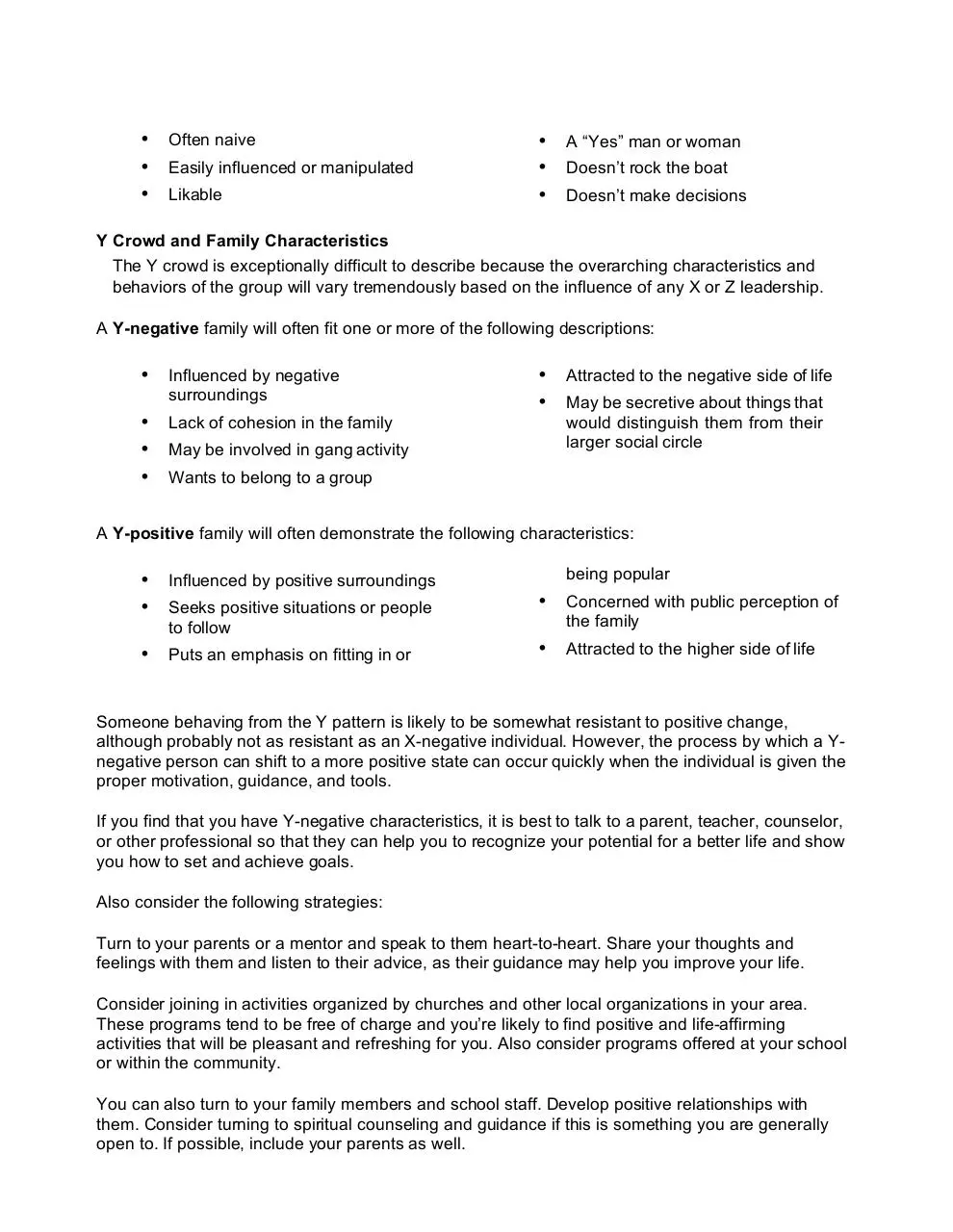Module 5 The Y Too Quick to Follow (PDF)
File information
Title: Untitled
This PDF 1.3 document has been generated by Word / Mac OS X 10.12.6 Quartz PDFContext, and has been sent on pdf-archive.com on 14/05/2018 at 14:55, from IP address 186.9.x.x.
The current document download page has been viewed 196 times.
File size: 36.62 KB (2 pages).
Privacy: public file


File preview
Module 5 – The Y: Too Quick to Follow
While someone acting from an X pattern often seems determined to remain stagnant by blaming
others, those acting from a Y pattern will usually stagnate until someone gives them a reason to
change. Such individuals typically follow a leader and are highly influenced by the attitude and
characteristics of that leader.
The X, Y and Z patterns of behavior can be found in people from all walks of life. Y is the most
common pattern and is where most people fit. Some Y-types grew up in families filled with other Ytypes, meaning they are primarily influenced by their environment, location, and the population.
Others may come from X families, yet have a bit more self-awareness and some idea of what they
would like to achieve.
A Y-type may also come from a primarily Z family but simply lack the ambition, drive or interest that
others in their family have. Regardless of their background, many Y-types lack attachment to a
location or the family life they come from. Such individuals often seem to attach to whatever or
whomever they are following.
Y-positive characteristics
Y-types can possess many Y-positive characteristics, but those traits are just not strong
enough to generate a sufficient level of ambition in that teen. Such characteristics may
include the following:
•
•
•
•
•
•
•
•
Indecisive/Usually open to direction
Late bloomer/Usually open to learning
Genial/Friendly and cheerful
Easy to get along with
Will provide loyal support to his or her leader
Observant
Good listener
Follows direction
Y-negative characteristics:
The negative characteristics of Y-types are often reflective of the Y individual’s environment and
the people in it. When the people in the environment of a Y lean toward the negative side, or
are X-types, the Y characteristics may include the following:
•
•
•
•
Co-dependent
Lost without a leader
Places a high value on acceptance
Easily conforms to negative peer pressure
The most negative characteristic of any Y is that they can be easily manipulated and may
follow the wrong path/peer groups in life.
How does society label a Y?
Society will usually label a person who would be considered a Y-type with several of the
following:
•
•
•
Often naive
Easily influenced or manipulated
Likable
•
•
•
A “Yes” man or woman
Doesn’t rock the boat
Doesn’t make decisions
Y Crowd and Family Characteristics
The Y crowd is exceptionally difficult to describe because the overarching characteristics and
behaviors of the group will vary tremendously based on the influence of any X or Z leadership.
A Y-negative family will often fit one or more of the following descriptions:
•
Influenced by negative
surroundings
•
•
•
Lack of cohesion in the family
•
•
May be involved in gang activity
Attracted to the negative side of life
May be secretive about things that
would distinguish them from their
larger social circle
Wants to belong to a group
A Y-positive family will often demonstrate the following characteristics:
being popular
•
•
Influenced by positive surroundings
Seeks positive situations or people
to follow
•
Concerned with public perception of
the family
•
Puts an emphasis on fitting in or
•
Attracted to the higher side of life
Someone behaving from the Y pattern is likely to be somewhat resistant to positive change,
although probably not as resistant as an X-negative individual. However, the process by which a Ynegative person can shift to a more positive state can occur quickly when the individual is given the
proper motivation, guidance, and tools.
If you find that you have Y-negative characteristics, it is best to talk to a parent, teacher, counselor,
or other professional so that they can help you to recognize your potential for a better life and show
you how to set and achieve goals.
Also consider the following strategies:
Turn to your parents or a mentor and speak to them heart-to-heart. Share your thoughts and
feelings with them and listen to their advice, as their guidance may help you improve your life.
Consider joining in activities organized by churches and other local organizations in your area.
These programs tend to be free of charge and you’re likely to find positive and life-affirming
activities that will be pleasant and refreshing for you. Also consider programs offered at your school
or within the community.
You can also turn to your family members and school staff. Develop positive relationships with
them. Consider turning to spiritual counseling and guidance if this is something you are generally
open to. If possible, include your parents as well.
Download Module 5 - The Y - Too Quick to Follow
Module 5 - The Y - Too Quick to Follow.pdf (PDF, 36.62 KB)
Download PDF
Share this file on social networks
Link to this page
Permanent link
Use the permanent link to the download page to share your document on Facebook, Twitter, LinkedIn, or directly with a contact by e-Mail, Messenger, Whatsapp, Line..
Short link
Use the short link to share your document on Twitter or by text message (SMS)
HTML Code
Copy the following HTML code to share your document on a Website or Blog
QR Code to this page

This file has been shared publicly by a user of PDF Archive.
Document ID: 0001874023.